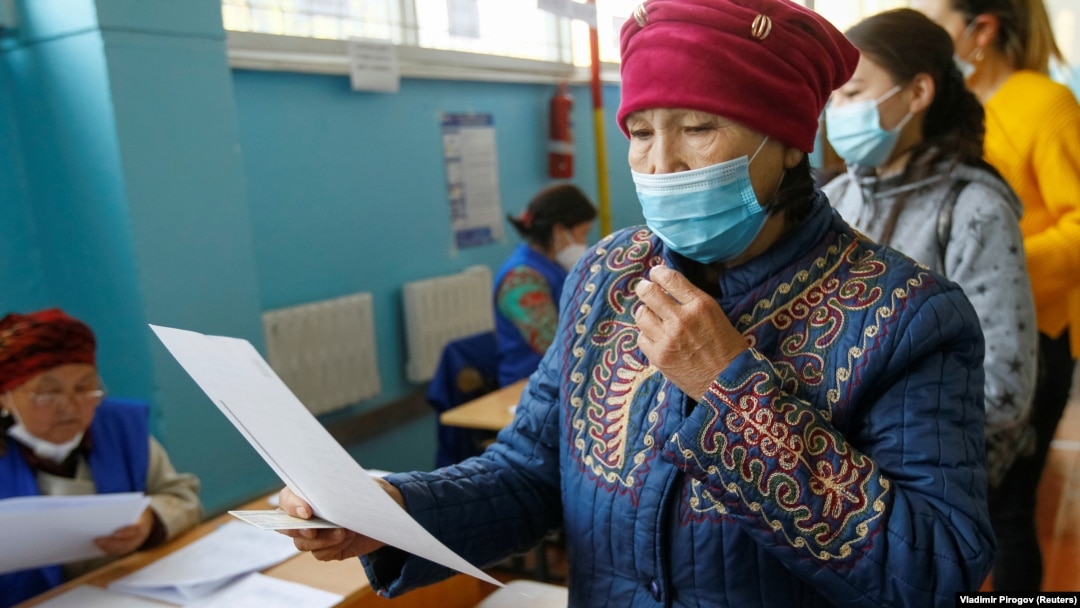Suspicions of election irregularities that marred two previous parliamentary elections in Kyrgyzstan triggered revolutions that ousted two separate presidents.
The Central Asian country will go to the polls again on November 28, and there are already accusations of misuse of funds and gerrymandering, the practice of redrawing electoral districts in a way that gives one political party or candidate an advantage.
New electoral laws have reduced the number of seats in parliament -- the Jogorku Kenesh, or Supreme Council -- from 120 to 90 seats. Of these, 54 seats will be elected through national party lists and the remaining 36 will be decided in single-mandate districts, also referred to as single-winner voting.
The new rules mean voting districts need to be redrawn, a contentious issue that has led to claims of foul play.
There are nearly 3.7 million eligible voters in Kyrgyzstan, according to the Central Election Commission (BShK), which decided each voting district should have around 100,000 voters.
The BShK finished redrawing the voting districts on September 5. But in a move that raised eyebrows, it then redrew several districts just days later.
"One of the main requirements of the districts is that the number of voters must be the same," Abdyjapar Bekmatov, a member of the BShK, told RFE/RL's Kyrgyz Service last month.
But Bekmatov, speaking after the first round of redistricting, said it had emerged "that in some districts there were 80,000 voters and in others 120,000 voters." Because of this, he said, "it was necessary to change the boundaries."
Not everyone was convinced by the official reasoning. "The map of the districts approved by the BShK has no logic," lawmaker Anvar Artykov told RFE/RL. Artykov said the redrawing of voting districts looked like "a group of people made decisions and created [favorable] conditions for four or five candidates."
Artykov is not alone in suspecting that some districts had been "tailor-made" for certain candidates.
"I was elected as a deputy in Bazar-Korgon," said lawmaker Saydulla Nyshanov, referring to a district in the southern region of Jalal-Abad. "Now it is being joined to Toguz-Torou [district]. These districts are not even directly connected by road."
Nyshanov added that Bazar-Korgon, which he said had 97,000 voters, should be a separate voting district.
Members of a local election commission count votes at a polling station in the village of Gornaya-Mayevka, outside Bishkek, on October 4, 2020.
The 36 seats that will be decided through single-mandate districts is the lowest in Kyrgyzstan's history.
In the 1995 and 2000 elections, Kyrgyzstan had a bicameral parliament. In 1995, parliament had 105 seats -- 35 in the Legislative Assembly and 70 in the Assembly of People's Representatives. All the seats were filled through voting in single-mandate districts.
The parliament elected in 2000 also had 105 seats -- 60 in the Legislative Assembly, 45 of which were filled by voting in single-mandate districts and 15 from party lists. Another 45 seats in the Assembly of People's Representatives were elected through voting in single-mandate districts.
In 2005, after constitutional changes restored a unicameral parliament, the number of seats was reduced to 75, all of them by voting in single-mandate districts.
Party Lists
New electoral laws, coming into effect on August 27, have also changed the national party-list system.
One of the biggest complaints about the party-list system was a perception that candidates needed to buy their way onto the list. The view was that the more money a candidate offered, the higher their position on a party's list. Rumors had suggested that candidates had to fork out up to $1 million to occupy the top places on a party's list.
If a party won five seats, the top five people on its list became parliamentary deputies. Sometimes, parties had more candidates on their list than there were seats in parliament.
That has changed. No party list can have more than 54 candidates, the number of seats available through party lists.
Previously, parties contesting parliamentary elections were assigned numbers on the ballots.
The Ata-Meken (Fatherland) party, for example, might be assigned number "6" on ballot papers. If voters want to cast ballots for Ata-Meken then they needed to check the box next to the number 6.
But under the new system, people can select a specific candidate from the party. That candidate also has a number on his or her party list, a move that observers say will create confusion on election day.
Lawmaker Janar Akaev says the changes to the party list system will not eliminate candidates from buying their way to the top of lists. "Now the most influential officials are recruiting rich people to the party," he told RFE/RL.
Vote-buying has been a problem in many of Kyrgyzstan's parliamentary elections. While Akaev did not name any specific parties, he suggests that these practices are still threatening the conduct of November's elections.
So far, about 75 parties have declared their intention to contest the vote, though that is likely to decrease to 20 or less before the elections.
The electoral changes could further taint the legitimacy of current President Sadyr Japarov, who was the architect of the reforms.
Japarov's government has been under growing scrutiny since his meteoric rise from prisoner to prime minister and then president in October 2020.
Kyrgyzstan's parliamentary elections have sparked unrest before 2020.
In 2005, parliamentary elections that saw numerous irregularities led to the ouster of the president and government.
A fairer election would help Japarov, who is increasingly unpopular for failing to make good on the many promises he made.
But already there are questions and suspicions about the conduct of these next elections.


